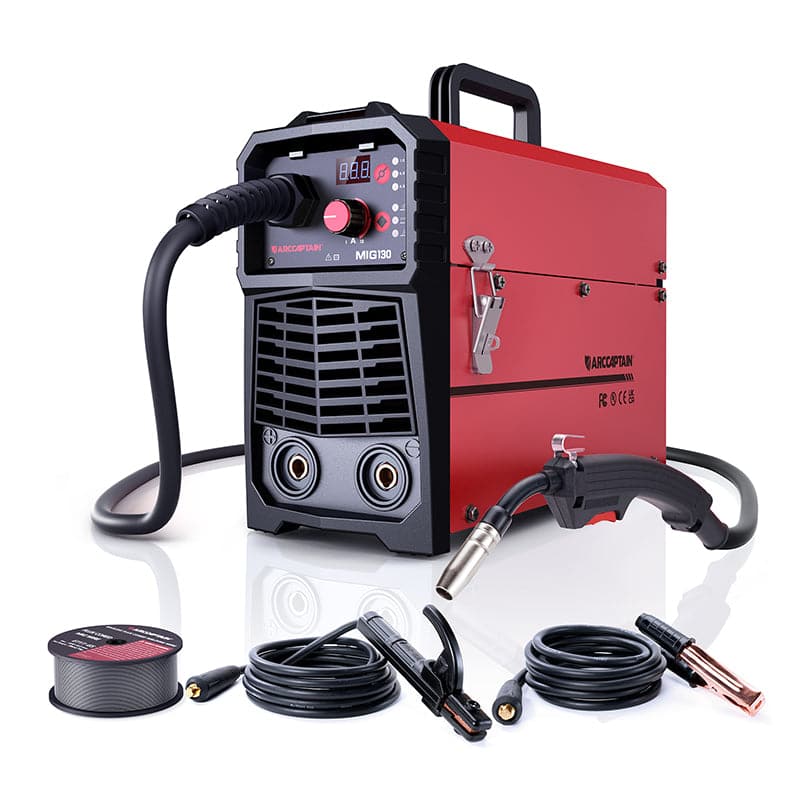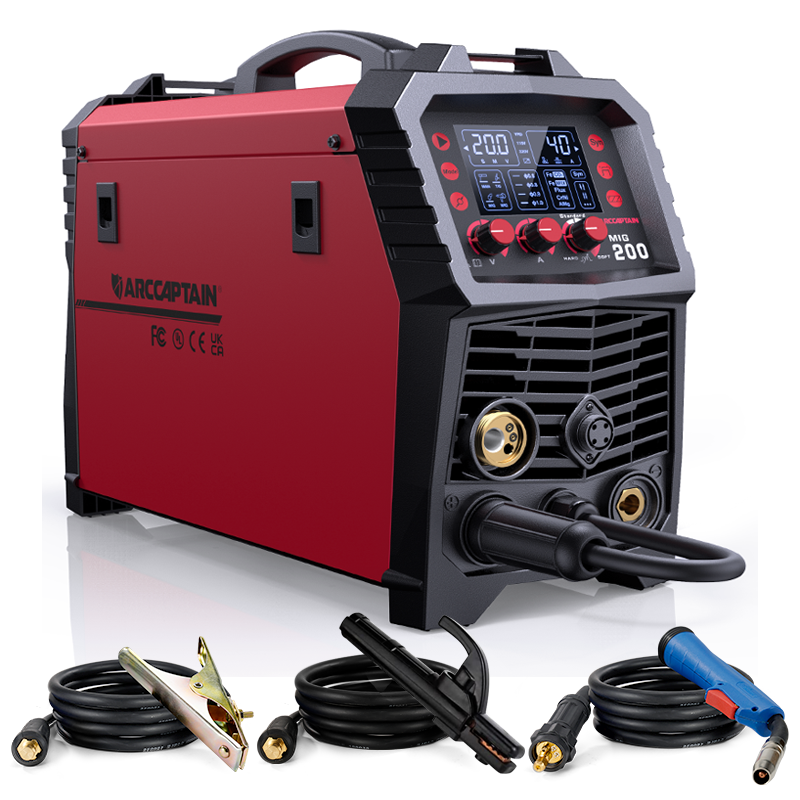
If you're looking for a welding process that can handle both thin sheet metal and thick materials, MIG welding might be just what you need. This process is relatively easy to master and can be used in almost all welding applications. However, the regular short circuit MIG transfer and even spray MIG transfer have their limitations.
Fortunately, new technologies are constantly emerging to improve and break the welding boundaries. In this article, we'll explore some of these new technologies and how they can benefit your welding projects.
How MIG Welding Works in Short
When it comes to MIG welding, there are two main metal transfer modes: short circuit and spray transfer. Both modes rely on a constant voltage power source and an automated wire feeder. Additionally, MIG welding requires a shielding gas. For welding steel, argon and carbon dioxide mixtures are most commonly used, while MIG welding aluminum requires 100% argon.
Short Circuit MIG Transfer
Short circuit transfer is the simplest and most common MIG welding mode. It works by depositing filler metal into the weld pool by melting the MIG wire at the point of contact between the tip of the wire and the welded metal. Essentially, the wire short circuits with the grounded metal and closes the electric circuit. As a result, the resistance of electrical current flow melts the wire, and the liquefied metal flows into the weld pool. Next, the wire feeder pushes more wire through the MIG gun, and the wire tip again short circuits, repeating the process over and over again many times per second.
This works well for most DIY or even professional jobs. But, short circuit transfer is messy. Every time the wire short circuits, it creates spatter. Despite this, short circuit transfer has numerous advantages. You can use it to weld in all positions and all steel thicknesses.
Spray MIG Transfer
Spray transfer doesn’t cause spatter and achieves an exceptionally high weld metal deposition rate. Plus, you can weld quickly and create deeply penetrating welds. The spray transfer arc never cuts out once established. Unlike with a short circuit, the filler metal is deposited in tiny droplets that “spray” from the wire’s tip to the welded metal. But, the wire never touches the base material; it melts at a distance into these tiny droplets of metal.
To achieve spray transfer when MIG welding, you must simultaneously crank up the wire feeding speed and the voltage output to higher values than for short circuit MIG gun. Additionally, you must use an Ar/CO2 mixture with at least 90% argon for quality spray mode. It’s necessary to utilize spray transfer to MIG weld aluminum because short circuit transfer creates poor results.
However, spray transfer only works in horizontal and flat positions because the weld puddle is too fluid and can fall on you if making out-of-position welds. Plus, it’s very challenging to use spray transfer to weld vertically uphill.
In summary, MIG welding is a fusion welding process that relies on a constant voltage power source and an automated wire feeder. Short circuit transfer is the simplest and most common MIG welding mode, while spray transfer achieves an exceptionally high weld metal deposition rate. Both modes have their advantages and disadvantages, and the choice between them depends on the welding configuration, welding transfer modes, and the filler metal used.
Pulsed MIG Welding
Pulsed MIG welding is a welding process that combines the benefits of spray transfer mode with the ability to weld vertically and in overhead positions. This is achieved by alternating the current between two values: peak current and background current. The peak current is high amperage, high wire feeding speed, and voltage that achieve spray transfer. The background current is lower in intensity and allows the puddle to solidify faster, giving you more control. The pulsing action happens tens or hundreds of times per second, depending on the settings on your MIG welding machine.
One of the advantages of pulse MIG welding is heat control. Since half of the pulse uses low current, it’s easier to avoid burning through or warping thin gauge metal. Plus, the puddle itself is more stable and easier to manage. This is particularly useful in out-of-position welding, where it can be difficult to maintain a stable arc.
Pulse MIG welding also offers reduced spatter and fume reduction. This is due to the controlled heat input and the pulsing capabilities of the process. The reduced spatter and fume make it a safer and cleaner process compared to other welding techniques.
Another advantage of pulse MIG welding is wire and gas savings. The controlled heat input and reduced spatter lead to a higher deposition rate, which means less wire and gas are needed to complete the weld. Additionally, the process is faster than other welding techniques, which saves time and money.
Single pulse MIG welders are often used in stainless steel and aluminum applications, where out-of-position welding is performed. Additionally, in auto repair shops, MIG brazing with silicon bronze works far better with pulse MIG welding.
Overall, pulse MIG welding is a spatterless process that offers high deposition rates, reduced heat input, reduced spatter and fume, and controlled heat input. It is a fast and efficient process that is suitable for a wide range of applications.
Double MIG Pulse Welding
Double pulse MIG welding, also known as pulse on pulse, is a welding process that adds another layer of pulsing into the waveform. This process uses two pulse currents that alternate, and each has its own peak and background currents. Double pulse MIG welding is capable of producing TIG-like welds, especially on non-ferrous metals like aluminum.
The additional pulse in double pulse MIG welding allows for the formation of the stack of dimes appearance. Since there are two different waves of pulses and each has a significant difference in current, each of the two pulses can alter the appearance of the weld. With some practice, it’s easy to learn how to replicate the TIG-like weld look.
Double pulse MIG welding provides slightly better heat control than single pulse MIG welding, which helps to reduce porosity and improve penetration depth. Additionally, this process has all the same benefits as single pulse MIG welding, including higher welding speeds, especially in spray transfer mode that’s native for pulse MIG welding.
In summary, double pulse MIG welding is an excellent option for those looking to achieve TIG-like welds on non-ferrous metals like aluminum. With its ability to provide better heat control, reduce porosity, and improve penetration depth, double pulse MIG welding is a popular choice for those looking to achieve exceptional-looking, shiny, and clean welds.
The Synergic Pulse and Double Pulse MIG Welding
Pulse MIG welding is a complex process that requires precise adjustments to various parameters. These include primary and background amps, voltage, wire feeding speed, pulse frequency, pulse balance, arc length, start and ending current, and more. Due to the lack of industry standards and the complexity of the settings, many manufacturers have developed pulse MIG welders with synergic modes. These modes use the best settings tested by the manufacturer and allow you to manually adjust only a few parameters.
Synergic power sources use waveform control technology to optimize the welding parameters for the specific material being welded. This technology adjusts the pulse parameters automatically, based on the welding speed and the thickness of the material. This results in a more stable arc and better weld quality.
Double pulse MIG welding adds another layer of pulsing into the waveform, resulting in the formation of a "stack of dimes" appearance. Unlike TIG, double pulse MIG welding still uses a consumable electrode and results in the basic spray transfer operation. This leaves you with a strong, solid, and highly aesthetically pleasing final weld bead.
Overall, the use of synergic pulse and double pulse MIG welding technology can result in improved weld quality and a more user-friendly experience.
See our Premium ArcCaptain Synergic MIG Welders


Conclusion
In conclusion, Pulse MIG welding can improve welding productivity, operator performance, cleanup, weld quality, aesthetics, cost savings, and versatility. However, most people don't need these advanced MIG welding features. If you make out-of-position welds or want maximum TIG-like weld quality, then getting a double pulse MIG-capable machine may be worth considering. It is important to note that pulse MIG welding machines are expensive and may not be necessary for beginner welders or professionals who don't require maximum MIG weld quality. Standard MIG welding machines are capable of producing great results and are a more cost-effective option. While these machines may cost less in the future, for now, investing in a pulse MIG welding machine is only recommended for high-end welding shops or professionals who require the maximum MIG weld quality.
Frequently Asked Questions
What Makes Pulse MIG Welding Different from Traditional MIG Welding?
Pulse MIG welding is different from traditional MIG welding in that it uses a pulsed current to deliver the filler metal to the weld joint. With traditional MIG welding, the current is continuous, which can lead to issues with overheating and burn-through. Pulse MIG welding allows for a more controlled and precise delivery of the filler metal, resulting in a cleaner and stronger weld.
Can You Explain the Advantages of Using Double Pulse MIG over Standard Pulse MIG?
Double Pulse MIG welding is an advanced technique that delivers two pulses of current to the weld joint instead of just one. This technique provides several advantages over standard Pulse MIG welding, including:
- Reduced heat input and distortion
- Improved control over the weld puddle
- Increased penetration and fusion
- Better control over the weld bead profile
What Are the Key Settings to Consider for Optimal Pulse MIG Welding on Aluminum?
When welding aluminum using Pulse MIG welding, there are several key settings to consider for optimal results. These include:
- Proper wire feed speed and voltage settings
- The use of a spool gun or push-pull gun to prevent wire feeding issues
- The use of a high-purity shielding gas, such as argon or helium, to prevent contamination
- Proper cleaning and preparation of the aluminum surface to remove any oils or contaminants that could affect the weld quality
How Does Pulse MIG Welding Affect the Quality and Strength of Welds on Mild Steel?
Pulse MIG welding can improve the quality and strength of welds on mild steel by providing better control over the weld puddle and reducing the risk of burn-through and distortion. This technique also allows for greater penetration and fusion, resulting in a stronger and more durable weld.
In What Scenarios Is Dual Pulse MIG Welding Preferred over Single Pulse?
Dual Pulse MIG welding is often preferred over single pulse in scenarios where a higher level of precision and control is required. This technique is particularly useful for welding thin materials, such as sheet metal, where burn-through and distortion can be a significant issue. Dual Pulse MIG welding can also be used to achieve a specific weld bead profile or to control the heat input and distortion of the weld.
What Are Some Common Challenges or Limitations When Using Pulse MIG Welding Techniques?
Some common challenges and limitations when using Pulse MIG welding techniques include:
- Difficulty controlling the weld puddle and bead profile
- The risk of burn-through or distortion, particularly when welding thin materials
- The need for precise control over the welding parameters, such as wire feed speed and voltage
- The need for specialized equipment, such as a spool gun or push-pull gun, for certain applications
Overall, Pulse MIG welding is a powerful and versatile welding technique that can provide significant benefits in terms of weld quality, strength, and precision. By understanding the key settings and techniques involved, you can achieve optimal results and overcome any challenges or limitations that may arise.

Really educating . great appreciation
Great appreciation for the info